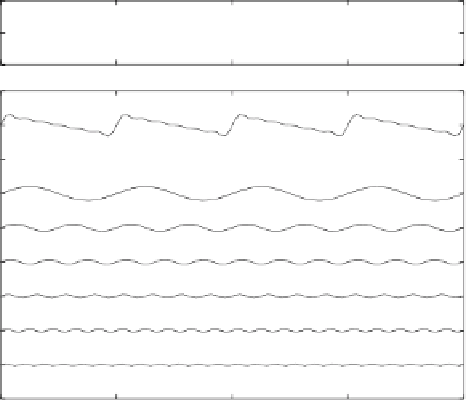Biomedical Engineering Reference
In-Depth Information
=
+
+
+
+
+
0
time (s)
0.003
Fig. 1.6.
Adding simple waves to create a complex sound. The wave at the top
is a complex oscillation known as a triangular or “sawtooth” wave. A simulated
sawtooth is shown below, formed by adding the first six harmonic components of
the sawtooth. The first component has the same period as the complex sound,
the second component has a period half of that (twice the frequency), the third
component has one-third the period (three times the frequency), etc. Note that the
amplitudes of the harmonic components decrease as we go to higher components.
The quantity and relative amplitudes of the harmonic components of a complex
sound make up the
spectral content
of the sound. Sounds with different spectral
contents are distinguished by our ear: we say they have different
timbres
f
(
t
)=
a
0
+
a
1
cos(
ω
1
t
)+
b
1
sin(
ω
1
t
)
+
a
2
cos(2
ω
1
t
)+
b
2
sin(2
ω
1
t
)
+
···
+
a
n
cos(
nω
1
t
)+
b
n
sin(
nω
1
t
)
+
···
,
(1.11)
where we have used, for notational simplicity, 2
πF
n
=
nω
1
. Equation (1.11)
is known as a
Fourier series
. The specific values of the amplitudes
a
n
and
b
n
can be computed by remembering the following equations:
T
sin(
nωt
)cos(
mωt
)
dt
=0
,
(1.12)
0
T
cos(
nωt
)cos(
mωt
)
dt
=
0
n
=
m,
(1.13)
T/
2
n
=
m,
0
sin(
nωt
) sin(
mωt
)
dt
=
0
T
n
=
m,
(1.14)
T/
2
n
=
m.
0


